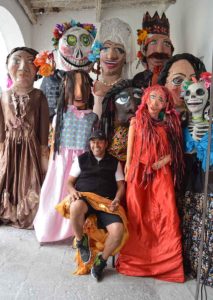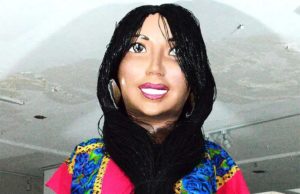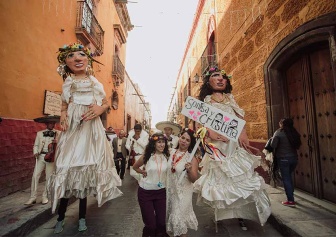Mojigangas woven into Mexican history
News Category: News, Community News, and General Discussion
-
Guanajuato’s San Miguel de Allende has made them internationally famous, but the giant dolls of Mexico are more than tourist attractions.
They can go by different names such as Monade Calender When GigantesBut the most well-known term is MojigangaUsed here.
The term comes from Spain and originally refers to a type of street theater, often associated with religious processes and included to provide comic relief. This usage can be found in several places, such as Sacualpan de Amilpas and Morelos in Mexico. their Mojiganga The event will take place in September with the celebration of the patron saint La Virgen del Rosario (Virgin of the Rosary).
But the words Mojiganga The meaning has changed much to refer to a one-meter-high doll designed to sit on the shoulders of a dancer along the street as a public pastime. The dancer/puppeteer is hidden by the figure’s skirt or robe and is perforated to allow the dancer to look into it.
Throughout Mexico Mojiganga, But most of the time, they are mixed media works. At least the doll’s head is made of papier-mache. Not only is it lacking in weight, but facial features can be as simple or fine as the craftsman wants.
A historical photo of a traditional Mojiganga figure in Patzcuaro, Michoacan.
In most places, the “skin” of the papier-mache extends under the torso and is usually reinforced with wood or metal. Famous for its paper-mâché work, Celaya is entirely made of paper-mâché, but most other places use other materials.The arms are generally made of stuffed animals that swing freely and do not hurt anyone who may hit them. Clothes are made from commercially available fabrics and are often colorful. Stretching this cloth down from the waist hides all the dancers except the legs that are part of the image. Hair can be made from a variety of materials, and certain items such as jewelry can be purchased commercially or made from scratch.
Depending on the area and purpose of the doll, Modigan gas Taking is very different. They pay homage to clothe, brides, bridesmaids, Mexican historical figures, demons, angels, pre-Hispanic priests, modern indigenous peoples, Mexican cultural figures, and sometimes non-Mexicos such as Gandhi and Albert Einstein. You can include a gorgeous blonde in revealing.
Some formats are “turcos” When “OrientallessIs a figure of Patzcuaro who refers to the history of the Moors of Spain and the heroes of the Revolutionary War who must appear in the celebration of San Miguel de Allende’s annual “El Grit” on the eve of Independence Day. But other people can take advantage of different cultural images, even a pure flight of fantasy.
Neither is uniform how, where, and when they appear. They are predominantly visible in central Mexico in Guanajuato, Michoacan, Guerrero, and Oaxaca. Even in these states, they are primarily confined to San Miguel Agende, Patzcuaro, and Oaxaca, Santo Tomasjarieza, and Quirapam in the city of Oaxaca, and their use has been documented for centuries.
They most often appear at the patron saint’s festival. In places like Patzcuaro, these are used only for this purpose. However, in many other places, locals have adopted them for a variety of purposes.

San Miguel’s most famous Modigan gas is Made for weddings, this also applies to Oaxaca. Another common use is often in Mexican restaurants and tourist shops, as a means of attracting customers to the business. Recently, Modigan gas We are performing in the Day of the Dead celebrations, especially for tourists.
No matter how you use it, it’s guaranteed to get attention, but dolls that are bigger than the real thing aren’t cheap. Production costs at least 6,000 pesos, but three times as much as in the wealthy regions of the country.
Dance as Mojiganga It’s not a meaningless feat. The doll’s waist strap puts all the weight on the dancer’s shoulders. San Miguel de Allende Maker Hermes Guerrero He says he tries to keep the weight of his work as low as possible, but it’s still over 20 kilograms. He also found that replacing the braided rope straps with ones made of rubber inner tubes not only made the weight a little easier but also made the doll more bounce.
The Modigan gas The people of San Miguel de Allende are most famous because, very simply, the large foreign population there has attracted the attention of international media outlets.
It’s easy to misunderstand that they were invented here and used only for party purposes, but that’s not the case. Modigan gas was Introduced to colonial Mexico by at least the 17th century, its use may be more widespread than it is today.
Patzcuaro historian Eugenio Calderon says that tradition has almost disappeared for some time after the revolution, as public religious exhibits have been outlawed. However, while religious festivals with elements like the Comic Party are widespread in Mexico, their use was probably declining before that. Modigan gas Not.

A much older traditional usage when it comes to party favors Modigan gas Outside the tourist center of San Miguel, dancing figures have been created and ceremonially burned for certain folk religious festivals, and remain.
There are some points to note Mojiganga Mexican manufacturer. Maestro Arroyo has the advantage of being based in San Miguel de Allende. In San Miguel de Allende, weddings and other commercial works often pay for what they make to celebrate the local community.
There is evidence that the use of dolls is slowly growing and spreading to new regions of Mexico: craftsmen such as Arroyo, Tonati Waist Lada I’m finding a business outside of my hometown, such as in Oaxaca.
Estrada did not start his crafting career with dolls. Originally a woodworker, I was disappointed that I couldn’t buy unharvested timber. He started by reestablishing a local tradition but is now shipping Modigan gas All over Mexico, especially west and northwest of the country.
It’s easy to catch up with the party and commercial aspects of these pieces, but they are an important part of Mexican history and culture. YouTube video blogger of Mexican culture and gastronomy, Carlos El Casta “They are Modigan gas It is an important part of our history and identity. While they are entertaining, they help strengthen the sense of community. “
Leigh Thelmadatter arrived in Mexico 18 years ago and fell in love with the land and culture, especially its handicrafts and arts. She is the author of Mexican Cartoneria: Paper, Paste, Fiesta (Schiffer 2019). Her cultural column is displayed regularly Mexico News Daily.
-


Leave a Reply